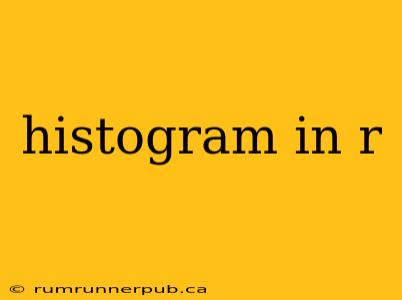Histograms are fundamental tools in data visualization, offering a quick and effective way to understand the distribution of a continuous variable. R, a powerful statistical computing language, provides several ways to create histograms, each with its own strengths and weaknesses. This article will explore various approaches, drawing upon insights from Stack Overflow, and enhance them with practical examples and explanations.
Understanding the Basics
Before diving into R code, let's clarify what a histogram represents. Unlike a bar chart which displays counts of categorical data, a histogram visualizes the distribution of a continuous variable by dividing the data into "bins" (intervals) and showing the frequency (or count) of observations falling within each bin. The height of each bar represents the frequency, providing a visual representation of data density.
Creating Histograms in R: A Multifaceted Approach
R offers several packages and functions for histogram creation. Let's explore some popular methods:
1. The hist() Function: The Built-in Solution
R's base graphics package provides the hist() function, a straightforward way to generate histograms.
Example (inspired by Stack Overflow discussions):
Let's create a histogram for a sample of normally distributed data:
data <- rnorm(1000) # Generate 1000 random numbers from a normal distribution
hist(data, main = "Histogram of Normal Data", xlab = "Values", ylab = "Frequency", col = "lightblue", border = "black")
This code generates a histogram with a title, labeled axes, a light blue fill, and black borders. We can customize many aspects, such as the number of bins (breaks), the color, and the labels. Refer to ?hist for detailed options.
Analysis: The hist() function's simplicity is its strength. It's ideal for quick visualizations. However, for more sophisticated customization, other packages might be preferable.
2. ggplot2 for Elegant Histograms
ggplot2, a powerful data visualization package, offers a more flexible and aesthetically pleasing approach.
Example (inspired by Stack Overflow solutions focusing on aesthetics and customization):
library(ggplot2)
ggplot(data.frame(data), aes(x = data)) +
geom_histogram(binwidth = 0.5, fill = "steelblue", color = "black", alpha = 0.7) +
labs(title = "Histogram of Normal Data using ggplot2", x = "Values", y = "Frequency") +
theme_bw()
This code utilizes ggplot2's grammar of graphics to create a visually appealing histogram with fine-grained control over aesthetics (binwidth, color, transparency). The theme_bw() function adds a clean black and white theme.
Analysis: ggplot2 offers unparalleled customization, making it suitable for creating publication-quality histograms. Its layered approach facilitates adding elements like density curves (discussed below).
3. Adding Density Curves for Enhanced Insight
Overlaying a density curve onto a histogram provides a smoother representation of the data's distribution, highlighting the underlying probability density function. This is particularly useful for identifying the shape of the distribution (e.g., normal, skewed).
Example (combining hist() and density()):
hist(data, main = "Histogram with Density Curve", xlab = "Values", ylab = "Frequency", col = "lightgray", border = "black", freq = FALSE) #freq=FALSE for density
lines(density(data), col = "blue", lwd = 2)
Here, freq = FALSE in hist() normalizes the histogram to density, allowing direct comparison with the density curve.
Analysis: Adding a density curve enhances the interpretability of the histogram, particularly for understanding the distribution's shape and potential underlying probability model.
Addressing Common Challenges: Stack Overflow Insights
Stack Overflow frequently addresses histogram-related issues. Let's consider a common problem: choosing the optimal number of bins. There isn't a single "correct" answer, but the nclass.Sturges and nclass.scott functions (available in base R) offer data-driven suggestions.
Conclusion
Creating effective histograms in R involves understanding the available tools and tailoring them to your specific needs. Whether you prefer the simplicity of hist(), the elegance of ggplot2, or the analytical power of density curves, R offers a flexible environment for visualising and interpreting data distributions. Remember to explore the many customization options to create clear and informative histograms for your analyses. By leveraging the insights gleaned from Stack Overflow and enhancing them with deeper explanations and practical examples, you can master the art of creating histograms in R.
